
Neon sign transformer power output
klugesmith, Sun Aug 26 2018, 01:57AMIs anyone else interested in how much HV power can be delivered by NST's, into resistive loads? The best documentation I've seen is an informal paper by Richard Hull, an old Tesla coiler, linked here on another forum:

One rule of thumb, from there, is that one might get 2/3 of nameplate OC voltage and 2/3 of nameplate SC current at the same time, into a resistive load chosen for maximum power. A more conservative expectation, consistent with a linear model, is 1/2 voltage and 1/2 current. In the case of a nominal 15 kV, 60 mA transformer, the maximum sustained power would be 400 W or 225 W.
As a first step toward data collection in my own lab, I just made a little battery-powered AC kilovoltmeter.
It's based on a voltage divider board from the flea market, whose resistors are mounted on PTFE-insulated eyelet terminals. Total resistance is about 90 megohms. Original design voltage is unknown. If we run it up to 18 kV, the meter current would be 200 microamperes and power dissipation would be 0.36 W per resistor. Max voltage per resistor would be 1800 volts, which I bet is OK even though the datasheet is missing.
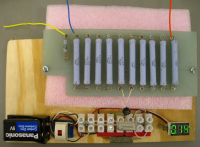

Things I would do differently next time: Power switch less susceptible to accidental pushing ON, mostly soldered connections instead of clunky screw terminal strip, and a battery test button.
Of course for AC input, it indicates the average rectified voltage. This cheap DVM reacted to 120 Hz ripple voltage by aliasing it to a much lower frequency, instead of rejecting it, so I added a filter capacitor. Rectifier needs to handle the divided voltage, not the full voltage. Forward drop of two diodes is an error term subtracting from full voltage. Maximum reverse leakage current in rectifier datasheet is 10 uA at 25 °C, which could cause substantial errors here, but is a super-conservative spec. I measured leakage on several specimens with 24 volts DC applied to the AC terminals. Chose the best: less than 40 nA in both directions (4 mV across a 100k resistor).
The first step for calibration was to measure the DVM response with respect to a 6-digit Agilent benchtop voltmeter. Between 0 and 15 V, the little meter reads about 0.6% low. Then I decided to calibrate for direct indication of RMS AC kilovoltage. A low voltage NST was dialed down to 950 V, as indicated by 1000 VAC range a handheld Fluke meter. Then the trimpot in picture was adjusted to make the divided voltage 956 mV (indicated as 0.95, occasionally 0.94). The little NST on Variac goes up to 4.4 kV AC, as indicated by new meter, but I have no independent measure of that.
Yesterday I tried a DC test with an industrial hipot tester, found "in calibration" and preset to 2.13 kV. New meter in picture indicated 2.44, apparently 14% or 15% higher than the true DC voltage. It ought to read 11.1% high, the ratio of sine wave RMS to rectified average voltage. Good enough for now!
Re: Neon sign transformer power output
Hazmatt_(The Underdog), Sun Aug 26 2018, 03:33AM
You might want to try capacitors too, you can use almost any value in a large string, and see how accurate that is too. The nice ones use caps in parallel with resistors.
I was playing with the idea of a capacitor divider, but life has been complicated for some time now, so I don't get much done anymore.

Hazmatt_(The Underdog), Sun Aug 26 2018, 03:33AM
You might want to try capacitors too, you can use almost any value in a large string, and see how accurate that is too. The nice ones use caps in parallel with resistors.
I was playing with the idea of a capacitor divider, but life has been complicated for some time now, so I don't get much done anymore.

Re: Neon sign transformer power output
Uspring, Mon Aug 27 2018, 11:29AM
Some time ago I tried to fit Hulls data to a simple model including some leakage inductance and secondary wire resistance. It didn't exactly fit, probably due to the neglectance of primary resistance, which enters the equations in a more complicated way than just adding some inductance and resistance to the secondary side of a perfect transformer. Within that approximation, the contribution of secondary wire resistance to the current limiting seemed small. As a result, max power output for a resistive load would be half the nameplate voltage current product at sqrt(1/2) of the nominal voltage.
Uspring, Mon Aug 27 2018, 11:29AM
Some time ago I tried to fit Hulls data to a simple model including some leakage inductance and secondary wire resistance. It didn't exactly fit, probably due to the neglectance of primary resistance, which enters the equations in a more complicated way than just adding some inductance and resistance to the secondary side of a perfect transformer. Within that approximation, the contribution of secondary wire resistance to the current limiting seemed small. As a result, max power output for a resistive load would be half the nameplate voltage current product at sqrt(1/2) of the nominal voltage.
Re: Neon sign transformer power output
Sulaiman, Mon Aug 27 2018, 09:34PM
One option is to use a ready made multimeter such as
then you can concentrate on the eht probe part ... a simple divider
as the meter can accurately indicate dc/rms current/voltage.
By building the eht probe as a dmm accessory
you get a new dmm :)
e.g. such a meter used as a milliammeter can be a dedicated in-circuit meter.
One problem would be the need to defeat the auto-off timer.
Sulaiman, Mon Aug 27 2018, 09:34PM
One option is to use a ready made multimeter such as

then you can concentrate on the eht probe part ... a simple divider
as the meter can accurately indicate dc/rms current/voltage.
By building the eht probe as a dmm accessory
you get a new dmm :)
e.g. such a meter used as a milliammeter can be a dedicated in-circuit meter.
One problem would be the need to defeat the auto-off timer.
Re: Neon sign transformer power output
klugesmith, Tue Aug 28 2018, 01:26AM
Uspring, I agree with your conclusion about 50% of nameplate V-I product at 70.7% V and I. Richard Hull's rule of thumb, 4/9 power at 2/3 V and I, allows for some winding resistance. My initial experiments last weekend fit the latter pretty well.
Here is yet another old forum thread about NST characteristics. It has lots of information and some arguing. Been a while since I saw the name of John DeArmond, a fellow I remember from pre-Internet Usenet days (1993-1994).
It has lots of information and some arguing. Been a while since I saw the name of John DeArmond, a fellow I remember from pre-Internet Usenet days (1993-1994).
Except in my own data from last weekend, I still have never seen a printed I-V curve for a NST output. Maybe Radiotech has one in a book.
My theoretical understanding was a bit too simplistic, until today. If the core and shunt materials had constant permeability, then consequent electrical parameters (magnetizing inductance, coupling coefficient, leakage inductance) would be independent of the operating point. The output I/V curve would be linear, since the leakage inductance would have a constant reactance at 60 Hz, eh? Ah, but the voltage drop due to leakage inductance is in quadrature with the voltage across a resistive load, as I'm sure Uspring knew first.
So the simple linear model of "AC voltage source with series inductance" yields an I-V curve that's one quadrant of a circle.
If we then include the in-phase voltage drop due to winding resistance, the curve from model is an intermediate shape much like those from my measurements.
Here's an example scaled to roughly match the little NST or ballast that got well measured here last Saturday.
]nst_iv4.jpg[/file] How come image thumbnails aren't working today?
Source impedances in the picture each have a magnitude of 500,000 ohms:
all real (500k resistor)
all imaginary (reactance of 1326 henries at 60 Hz)
a hypothetical mixture (100k + j*490k).
Real data, to be presented when I have more time and some photographs, show some minor effects from nonlinear magnetization of the core and shunts.
But I bet linear LR models will be plenty useful for most predictions, such as what would happen if we put capacitors in the circuit.
klugesmith, Tue Aug 28 2018, 01:26AM
Uspring, I agree with your conclusion about 50% of nameplate V-I product at 70.7% V and I. Richard Hull's rule of thumb, 4/9 power at 2/3 V and I, allows for some winding resistance. My initial experiments last weekend fit the latter pretty well.
Here is yet another old forum thread about NST characteristics.
 It has lots of information and some arguing. Been a while since I saw the name of John DeArmond, a fellow I remember from pre-Internet Usenet days (1993-1994).
It has lots of information and some arguing. Been a while since I saw the name of John DeArmond, a fellow I remember from pre-Internet Usenet days (1993-1994). Except in my own data from last weekend, I still have never seen a printed I-V curve for a NST output. Maybe Radiotech has one in a book.
My theoretical understanding was a bit too simplistic, until today. If the core and shunt materials had constant permeability, then consequent electrical parameters (magnetizing inductance, coupling coefficient, leakage inductance) would be independent of the operating point. The output I/V curve would be linear, since the leakage inductance would have a constant reactance at 60 Hz, eh? Ah, but the voltage drop due to leakage inductance is in quadrature with the voltage across a resistive load, as I'm sure Uspring knew first.
So the simple linear model of "AC voltage source with series inductance" yields an I-V curve that's one quadrant of a circle.
If we then include the in-phase voltage drop due to winding resistance, the curve from model is an intermediate shape much like those from my measurements.
Here's an example scaled to roughly match the little NST or ballast that got well measured here last Saturday.
]nst_iv4.jpg[/file] How come image thumbnails aren't working today?
Source impedances in the picture each have a magnitude of 500,000 ohms:
all real (500k resistor)
all imaginary (reactance of 1326 henries at 60 Hz)
a hypothetical mixture (100k + j*490k).
Real data, to be presented when I have more time and some photographs, show some minor effects from nonlinear magnetization of the core and shunts.
But I bet linear LR models will be plenty useful for most predictions, such as what would happen if we put capacitors in the circuit.
Re: Neon sign transformer power output
Uspring, Wed Aug 29 2018, 08:45AM
I^2 * (2*pi*f*L)^2 + V^2 = V0^2
where f is the frequency, L the leakage inductance and V0 the NST unloaded output voltage. That's indeed a circle or an ellipse, depending on the axis scaling.
A more complete equation including the secondary wire resistance Rw is:
I^2 * (2*pi*f*L)^2 + (V + I*Rw)^2 = V0^2
In the extreme case of negligible leakage inductance, that corresponds to a straight line V-I diagram.
Dunno if the primary wire resistance can be lumped into Rw. The equations become unwieldy.
Uspring, Wed Aug 29 2018, 08:45AM
So the simple linear model of "AC voltage source with series inductance" yields an I-V curve that's one quadrant of a circle.For a negligible wire resistance V and I are related by:
I^2 * (2*pi*f*L)^2 + V^2 = V0^2
where f is the frequency, L the leakage inductance and V0 the NST unloaded output voltage. That's indeed a circle or an ellipse, depending on the axis scaling.
A more complete equation including the secondary wire resistance Rw is:
I^2 * (2*pi*f*L)^2 + (V + I*Rw)^2 = V0^2
In the extreme case of negligible leakage inductance, that corresponds to a straight line V-I diagram.
Dunno if the primary wire resistance can be lumped into Rw. The equations become unwieldy.
Re: Neon sign transformer power output
Sulaiman, Wed Aug 29 2018, 11:15AM
I consider a NST as a transformer with a very large series inductance,
the reactance is MUCH greater than the resistance - which can mostly be ignored.
So we are left with only a few parameters of significance;
. no-load voltage per namplate ratings.
As far as I know, an NST can run continuously with no load.
. short-circuit current per nameplate ratings.
As far as I know, an NST can operate into a short-circuit continuously.
So
. we can use ANY value of resistance as a load with little fear of damaging the NST
. when the NST load has capacitance things get more interesting,
especially when the capacitance is close to the capacitance required for resonance.
To recap for newer readers,
the output impedance of an NST is almost completely inductive,
the impedance is simply (nameplate voltage)/(nameplate current)
e.g. for a 50Hz, 5-0-5 kV, 20mA NST the output impedance is 10,000/0.02 = 500,000 Ohm (inductive)
so the inductance is 500,000/(2.pi.50) = 1,591 Henry !
At 50 Hz 1,591 H is resonant with 1/(1591 x (2.pi.50)^2) F = 6.37 nF
so, if the only load is a capacitor of about 6.37 nF the output
current should approach Vac/Rdc ... several amperes
voltage should be Vac x Q ... hundreds of thousands or millions of volts !
Luckily this will not happen due to current-limiting caused by the magnetic shunts
and more significantly core saturation.
There will however be enough over-voltage or over-current to kill the NST
this is why we use safety spark gaps or similar.
So, if your NST load is effectively resistive (this includes ac rectified to dc) there should be no problems
but if the load is capacitive, make sure that it is not resonant (or use other safety measures)
Sulaiman, Wed Aug 29 2018, 11:15AM
I consider a NST as a transformer with a very large series inductance,
the reactance is MUCH greater than the resistance - which can mostly be ignored.
So we are left with only a few parameters of significance;
. no-load voltage per namplate ratings.
As far as I know, an NST can run continuously with no load.
. short-circuit current per nameplate ratings.
As far as I know, an NST can operate into a short-circuit continuously.
So
. we can use ANY value of resistance as a load with little fear of damaging the NST
. when the NST load has capacitance things get more interesting,
especially when the capacitance is close to the capacitance required for resonance.
To recap for newer readers,
the output impedance of an NST is almost completely inductive,
the impedance is simply (nameplate voltage)/(nameplate current)
e.g. for a 50Hz, 5-0-5 kV, 20mA NST the output impedance is 10,000/0.02 = 500,000 Ohm (inductive)
so the inductance is 500,000/(2.pi.50) = 1,591 Henry !
At 50 Hz 1,591 H is resonant with 1/(1591 x (2.pi.50)^2) F = 6.37 nF
so, if the only load is a capacitor of about 6.37 nF the output
current should approach Vac/Rdc ... several amperes
voltage should be Vac x Q ... hundreds of thousands or millions of volts !
Luckily this will not happen due to current-limiting caused by the magnetic shunts
and more significantly core saturation.
There will however be enough over-voltage or over-current to kill the NST
this is why we use safety spark gaps or similar.
So, if your NST load is effectively resistive (this includes ac rectified to dc) there should be no problems
but if the load is capacitive, make sure that it is not resonant (or use other safety measures)
Re: Neon sign transformer power output
klugesmith, Sat Sept 01 2018, 10:41PM
First: applause for Sulaiman's suggestion of putting a general purpose DMM on the low side of voltage divider. That would automatically take care of AC/DC scaling, and true-RMS option is available to the DMM buyer. There's a catch, other than automatic power-down time. Cheap DMMs like mine have no ACV range lower than 200V. I was about to say, that would require an upgrade of bridge rectifier voltage. Nope, not with an AC meter!
This little transformer is responsible for first set of data from my lab.
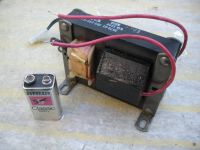
Core laminations have no joints on the outside perimeter. Looks like the center leg is pressed into the outer section, a thing I've seen before in small motors but not previously in a transformer. Shunts have well-defined air gaps without need of paper spacers. Here sketched from a photograph.
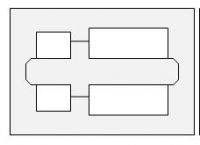
Without further ado, here are the measured I-V curves for five different primary voltages and six different resistive loads, plus a luminous tube.
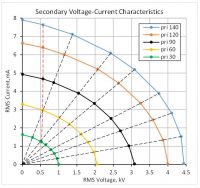
Black dashed lines connect the measured V,I points for each resistor configuration. Their straightness adds confidence that the measurements were transcribed properly. A red dashed line connects the measured V,I points for the luminous tube, which lit up fine even as primary voltage was variac'd up from 0 to 30 V.
In the next chart, the numbers are normalized to the measured V_OC and I_SC for each primary voltage. Colors are the same. On close inspection, the curve shapes are slightly sensitive to primary voltage. I bet that's from magnetic nonlinearity in the steel.

I added an iso-power line passing through V = 2/3, I = 2/3 point in Richard Hull's old rule of thumb. So close to my "nominal primary voltage" measured curve, I wonder if the experiment was somehow rigged.
My intended application is on the lightly loaded, higher voltage side of the chart. With _this_ specimen, we can get 50% current at 80% voltage, or 35% current at 90% voltage.
Here are more details about the experiment set.
1. Chose one small shunted HV transformer with no nameplate. Primary behaves like it's designed for 120 V, 60 Hz. Then secondary V_oc is about 4 kV, and secondary I_sc is about 7 mA.
2. Used it with a variac, some power resistors, one "neon" element, and three digital meters:
- Benchtop 6-digit multimeter with Agilent brand, for true RMS AC volt measurement at transformer primary.
- Handheld multimeter with Fluke brand, for true RMS AC mA measurement in series with transformer primary or secondary. Secondary current metering won't be so trivial when running at 15+ kV.
- Homemade AC kilovoltmeter presented in OP, used exclusively for AC volt measurement at transformer secondary.
3. Primary voltage was adjusted, using variac, to measured values closely approximating whole multiples of 10 V. All charts are based on the nominal step voltages, not the actual measured values.
4. Measured primary current, with secondary open and secondary shorted, from 10 V to 140 V. Both show incipient saturation at 140 V.
5. For the same set of primary voltages, measured secondary voltage loaded only by voltmeter (90-megohm), and secondary current burdened only by milliammeter (about 1 ohm).
6. For about six different resistive loads, and one luminous tube, primary voltage was set to 30, 60, 90, 120, and 140 V as measured. At each setting I recorded the voltage and current at secondary. That's more tedious than computing one from the other and the known resistance. It offers some protection against transcription blunders, because the computed V/I ratios should be constant in each sweep.
klugesmith, Sat Sept 01 2018, 10:41PM
First: applause for Sulaiman's suggestion of putting a general purpose DMM on the low side of voltage divider. That would automatically take care of AC/DC scaling, and true-RMS option is available to the DMM buyer. There's a catch, other than automatic power-down time. Cheap DMMs like mine have no ACV range lower than 200V. I was about to say, that would require an upgrade of bridge rectifier voltage. Nope, not with an AC meter!
This little transformer is responsible for first set of data from my lab.

Core laminations have no joints on the outside perimeter. Looks like the center leg is pressed into the outer section, a thing I've seen before in small motors but not previously in a transformer. Shunts have well-defined air gaps without need of paper spacers. Here sketched from a photograph.

Without further ado, here are the measured I-V curves for five different primary voltages and six different resistive loads, plus a luminous tube.

Black dashed lines connect the measured V,I points for each resistor configuration. Their straightness adds confidence that the measurements were transcribed properly. A red dashed line connects the measured V,I points for the luminous tube, which lit up fine even as primary voltage was variac'd up from 0 to 30 V.
In the next chart, the numbers are normalized to the measured V_OC and I_SC for each primary voltage. Colors are the same. On close inspection, the curve shapes are slightly sensitive to primary voltage. I bet that's from magnetic nonlinearity in the steel.

I added an iso-power line passing through V = 2/3, I = 2/3 point in Richard Hull's old rule of thumb. So close to my "nominal primary voltage" measured curve, I wonder if the experiment was somehow rigged.

My intended application is on the lightly loaded, higher voltage side of the chart. With _this_ specimen, we can get 50% current at 80% voltage, or 35% current at 90% voltage.
Here are more details about the experiment set.
1. Chose one small shunted HV transformer with no nameplate. Primary behaves like it's designed for 120 V, 60 Hz. Then secondary V_oc is about 4 kV, and secondary I_sc is about 7 mA.
2. Used it with a variac, some power resistors, one "neon" element, and three digital meters:
- Benchtop 6-digit multimeter with Agilent brand, for true RMS AC volt measurement at transformer primary.
- Handheld multimeter with Fluke brand, for true RMS AC mA measurement in series with transformer primary or secondary. Secondary current metering won't be so trivial when running at 15+ kV.
- Homemade AC kilovoltmeter presented in OP, used exclusively for AC volt measurement at transformer secondary.
3. Primary voltage was adjusted, using variac, to measured values closely approximating whole multiples of 10 V. All charts are based on the nominal step voltages, not the actual measured values.
4. Measured primary current, with secondary open and secondary shorted, from 10 V to 140 V. Both show incipient saturation at 140 V.
5. For the same set of primary voltages, measured secondary voltage loaded only by voltmeter (90-megohm), and secondary current burdened only by milliammeter (about 1 ohm).
6. For about six different resistive loads, and one luminous tube, primary voltage was set to 30, 60, 90, 120, and 140 V as measured. At each setting I recorded the voltage and current at secondary. That's more tedious than computing one from the other and the known resistance. It offers some protection against transcription blunders, because the computed V/I ratios should be constant in each sweep.
Re: Neon sign transformer power output
Sulaiman, Sun Sept 02 2018, 12:51AM
Nice work, the data points are in excellent agreement with each other.
Thanks for sharing the graphs.
Some good details in there.
Sulaiman, Sun Sept 02 2018, 12:51AM
Nice work, the data points are in excellent agreement with each other.
Thanks for sharing the graphs.
Some good details in there.
Re: Neon sign transformer power output
klugesmith, Sat Sept 22 2018, 11:20PM
Next step is progressing slowly, so here's a progress report. Want to measure AC or DC currents up to, say, 60 mA in high voltage circuits. For example, a loaded NST with both sides at high voltage. A self-contained, float-able milliammeter seems to be easier than a current transformer or optoisolator (for AC or DC, 10's of mA, maybe over 10 kV).
Decided to go the digital route. Chose a tiny 3 digit LED panel meter just like the one in OP, powered by 9V battery.
Current under test goes through full-wave bridge rectifier and a 100 ohm burden resistor.
99.9 mA develops 9.99 volts and is displayed as 9.99, with 1 watt dissipated in the resistor.
I have similar panel meters made to measure DC current, with much less wasteful voltage drop. But their shunt R's are much less than 1 ohm. It would take an inordinately large capacitance to mitigate the 120 Hz ripple, when measuring rectified AC.
It took just a few minutes to build and test the whole circuit in breadboard form. Then hours, so far, putting it into a corona-resistant metal enclosure. The box has room for all the parts. So far, all that's installed is the DPM and a set of home-made receptacles for banana plugs.


[edit] Forgot to mention giving fair consideration to Sulaiman's suggestion, to use a general purpose digital multimeter. In fact, I bought an extra one of the $3 or $5 type. Then discovered that they're even more limited than I thought, for measuring AC.
Obviously no AC current range, or AC voltage range lower than 200 V. But with the voltage divider in OP changed to 100:1, 15 kV would be displayed as 150.0. No need to get a higher voltage rectifier -- just omit the rectifier.
Most good digital multimeters have an input impedance of 10 megohms in voltage mode. Many of us know that the cheap ones are typically 1 megohm, which would barely be OK.
Turns out that's only for DC voltage mode. My two "good" meters, on AC volts, look like infinite DC resistance. Apparently AC coupled. No response to DC of either polarity. (That's good to know, when looking at mixed DC and AC. If you want to know the true RMS value of mixed waveform, compute it from separate measurements in DC and AC modes.)
Then measured the input resistance of two different "cheap" DMMs on 200 VAC mode. Both looked like about 0.52 megohms in one direction and infinite in the other. With +10 VDC on input, both displayed 21 V. With -10 VDC, both displayed zero. No longer attractive for easy scaling to kilovolts AC.
In some other post, because it's in picture form, I'll present my input resistance measurements from six different multimeters. On all AC and DC voltage ranges, ohmed in both directions.
klugesmith, Sat Sept 22 2018, 11:20PM
Next step is progressing slowly, so here's a progress report. Want to measure AC or DC currents up to, say, 60 mA in high voltage circuits. For example, a loaded NST with both sides at high voltage. A self-contained, float-able milliammeter seems to be easier than a current transformer or optoisolator (for AC or DC, 10's of mA, maybe over 10 kV).
Decided to go the digital route. Chose a tiny 3 digit LED panel meter just like the one in OP, powered by 9V battery.
Current under test goes through full-wave bridge rectifier and a 100 ohm burden resistor.
99.9 mA develops 9.99 volts and is displayed as 9.99, with 1 watt dissipated in the resistor.
I have similar panel meters made to measure DC current, with much less wasteful voltage drop. But their shunt R's are much less than 1 ohm. It would take an inordinately large capacitance to mitigate the 120 Hz ripple, when measuring rectified AC.
It took just a few minutes to build and test the whole circuit in breadboard form. Then hours, so far, putting it into a corona-resistant metal enclosure. The box has room for all the parts. So far, all that's installed is the DPM and a set of home-made receptacles for banana plugs.


[edit] Forgot to mention giving fair consideration to Sulaiman's suggestion, to use a general purpose digital multimeter. In fact, I bought an extra one of the $3 or $5 type. Then discovered that they're even more limited than I thought, for measuring AC.
Obviously no AC current range, or AC voltage range lower than 200 V. But with the voltage divider in OP changed to 100:1, 15 kV would be displayed as 150.0. No need to get a higher voltage rectifier -- just omit the rectifier.

Most good digital multimeters have an input impedance of 10 megohms in voltage mode. Many of us know that the cheap ones are typically 1 megohm, which would barely be OK.
Turns out that's only for DC voltage mode. My two "good" meters, on AC volts, look like infinite DC resistance. Apparently AC coupled. No response to DC of either polarity. (That's good to know, when looking at mixed DC and AC. If you want to know the true RMS value of mixed waveform, compute it from separate measurements in DC and AC modes.)
Then measured the input resistance of two different "cheap" DMMs on 200 VAC mode. Both looked like about 0.52 megohms in one direction and infinite in the other. With +10 VDC on input, both displayed 21 V. With -10 VDC, both displayed zero. No longer attractive for easy scaling to kilovolts AC.
In some other post, because it's in picture form, I'll present my input resistance measurements from six different multimeters. On all AC and DC voltage ranges, ohmed in both directions.
Re: Neon sign transformer power output
radiotech, Tue Sept 25 2018, 07:23AM
If you passed a constant DC current through the secondary
in the range of the rated RMS current, the voltage across
the winding would increase as the winding heated.
This would give R/t curve. At any point in the curve
you would know wattage dissipated in the winding.
The core loss would not enter into this value.
The winding temperature also would be known with the
copper wire constants.
With AC current, equated to temperature rise and
resistance , the actual out put power would be know,
by maximum power transfer theorem, from resistance of winding
to resistance of resistor load. Reactance could not affect this
because heat is the determinant.
But now comes the realization that the output power of
any transformer is temperature dependent.
radiotech, Tue Sept 25 2018, 07:23AM
If you passed a constant DC current through the secondary
in the range of the rated RMS current, the voltage across
the winding would increase as the winding heated.
This would give R/t curve. At any point in the curve
you would know wattage dissipated in the winding.
The core loss would not enter into this value.
The winding temperature also would be known with the
copper wire constants.
With AC current, equated to temperature rise and
resistance , the actual out put power would be know,
by maximum power transfer theorem, from resistance of winding
to resistance of resistor load. Reactance could not affect this
because heat is the determinant.
But now comes the realization that the output power of
any transformer is temperature dependent.
Re: Neon sign transformer power output
Sulaiman, Tue Sept 25 2018, 03:32PM
kludgesmith has either faked his graph (I do not believe that)
or done some careful measurements and kindly shared his data with us.
Look at his graph then give answers or theories that fit the data.
Or supply better data.
Sulaiman, Tue Sept 25 2018, 03:32PM
kludgesmith has either faked his graph (I do not believe that)
or done some careful measurements and kindly shared his data with us.

Look at his graph then give answers or theories that fit the data.
Or supply better data.
Re: Neon sign transformer power output
radiotech, Tue Sept 25 2018, 09:04PM
The original question was how much power
can a neon sign transformer deliver ?
I fetched a neon transformer on hand.
5000 volts 0.018 Amps secondary.
The DC resistance of the room temperature was 16,500 ohms.
I set my Clarostat power to 16,000 ohms.
With a milliamp meter in series, I adjusted the primary
voltage to 110 volts 60 Hz.
The secondary current was 0.018 amps, trim set with variac.
The AC voltage across the resistor was 280 volts.
The output power was about 5 watts.
I believe that these transformers do not operate at
high voltage, but furnish it to strike the load.
Transformer makers rate in volt amps on the primary,
and feet of tubing of a certain diameter they light.
So in fine detail, the stable (temperature) resistance of the secondary
would determine the power output.
radiotech, Tue Sept 25 2018, 09:04PM
The original question was how much power
can a neon sign transformer deliver ?
I fetched a neon transformer on hand.
5000 volts 0.018 Amps secondary.
The DC resistance of the room temperature was 16,500 ohms.
I set my Clarostat power to 16,000 ohms.
With a milliamp meter in series, I adjusted the primary
voltage to 110 volts 60 Hz.
The secondary current was 0.018 amps, trim set with variac.
The AC voltage across the resistor was 280 volts.
The output power was about 5 watts.
I believe that these transformers do not operate at
high voltage, but furnish it to strike the load.
Transformer makers rate in volt amps on the primary,
and feet of tubing of a certain diameter they light.
So in fine detail, the stable (temperature) resistance of the secondary
would determine the power output.
Re: Neon sign transformer power output
klugesmith, Sun Nov 18 2018, 07:00AM
Back at last, with two different topics. In two back-to-back posts.
First: respect for Radiotech's suggestions. I measured the DC resistances of both windings in that little 4000 volt transformer. 26.5K secondary. 14.4 ohms primary (equivalent to 16K in secondary circuit, if this were a regular, tightly coupled power transformer). Total 42.5K, for theoretical short-circuit current of 94 mA, and maximum power 94 watts into 42.5K load. (2000 V x 47 mA).
We saw that the actual short-circuit current is only 6.6 mA, implying that internal impedance is about 606K. This chart shows output I vs V if the 606K were real (resistive), imaginary (as from 1607 henries at 60 Hz), or a mixture that closely fits actual observations: 601K from inductance and 76K from resistance.
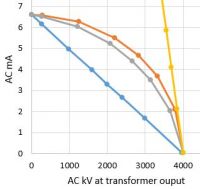
It came as a surprise that the resistance needed to be that high (in spreadsheet calculator simulation) to get 2/3 of open circuit voltage and 2/3 of short circuit current. Max power 11.73 watts, with 606K load. The voltage and current factor would be 0.707 if internal impedance were purely inductive.
Makes me want to re-measure the device with new instruments (see following post). Will include loads that match DC winding resistance, as Radiotech did. Expect their current to be about the same as into a short circuit, say 6.5 mA, for power of a watt or two.
External capacitors could, I bet, allow more short circuit current and/or more open circuit voltage. Maybe even more real powah, at the cost of stresses that the transformer isn't designed for. Plenty of videos on youtube, by people who like using high voltage power transformers to make arcs.
klugesmith, Sun Nov 18 2018, 07:00AM
Back at last, with two different topics. In two back-to-back posts.
First: respect for Radiotech's suggestions. I measured the DC resistances of both windings in that little 4000 volt transformer. 26.5K secondary. 14.4 ohms primary (equivalent to 16K in secondary circuit, if this were a regular, tightly coupled power transformer). Total 42.5K, for theoretical short-circuit current of 94 mA, and maximum power 94 watts into 42.5K load. (2000 V x 47 mA).
We saw that the actual short-circuit current is only 6.6 mA, implying that internal impedance is about 606K. This chart shows output I vs V if the 606K were real (resistive), imaginary (as from 1607 henries at 60 Hz), or a mixture that closely fits actual observations: 601K from inductance and 76K from resistance.

It came as a surprise that the resistance needed to be that high (in spreadsheet calculator simulation) to get 2/3 of open circuit voltage and 2/3 of short circuit current. Max power 11.73 watts, with 606K load. The voltage and current factor would be 0.707 if internal impedance were purely inductive.
Makes me want to re-measure the device with new instruments (see following post). Will include loads that match DC winding resistance, as Radiotech did. Expect their current to be about the same as into a short circuit, say 6.5 mA, for power of a watt or two.
External capacitors could, I bet, allow more short circuit current and/or more open circuit voltage. Maybe even more real powah, at the cost of stresses that the transformer isn't designed for. Plenty of videos on youtube, by people who like using high voltage power transformers to make arcs.
Re: Neon sign transformer power output
klugesmith, Sun Nov 18 2018, 07:32AM
Came to present new work, finally putting the Altoids-box mA meter into service.
Tonight I measured the first of my 15-60 NST's, with primary voltages of 60, 120, and 140, and loads of short, luminous tube, 1R, 2R, 4R, 8R, and open circuit.
277 V on primary will come tomorrow, if I have time.
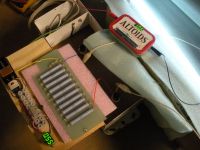

The I-V chart is unremarkable, except for showing an apparent blunder in transcribing a reading at 60V input and 1R load. And the I values don't include the voltmeter current.
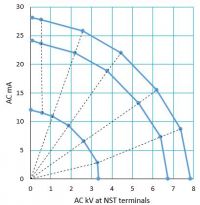
Here's a close-up of the new instrument. The power switch is in middle position, to read the battery voltage when loaded by our 100 ohm current sense resistor.

A full scale reading on the digital panel meter would be 300 mA, with 9 watts in the resistor. In case that's ever wanted, briefly, the R is as big and as thermally isolated as I could easily manage, short of thermal attachment to the case and/or air holes. Next time, get a panel meter with a more appropriate native voltage range, like 2V or 0.2 V.
It would have been much easier to put a small analog mA meter in a box, with a similar bridge rectifier. But that wouldn't be so easy to read precisely from a safe distance.
klugesmith, Sun Nov 18 2018, 07:32AM
Came to present new work, finally putting the Altoids-box mA meter into service.
Tonight I measured the first of my 15-60 NST's, with primary voltages of 60, 120, and 140, and loads of short, luminous tube, 1R, 2R, 4R, 8R, and open circuit.
277 V on primary will come tomorrow, if I have time.


The I-V chart is unremarkable, except for showing an apparent blunder in transcribing a reading at 60V input and 1R load. And the I values don't include the voltmeter current.

Here's a close-up of the new instrument. The power switch is in middle position, to read the battery voltage when loaded by our 100 ohm current sense resistor.

A full scale reading on the digital panel meter would be 300 mA, with 9 watts in the resistor. In case that's ever wanted, briefly, the R is as big and as thermally isolated as I could easily manage, short of thermal attachment to the case and/or air holes. Next time, get a panel meter with a more appropriate native voltage range, like 2V or 0.2 V.
It would have been much easier to put a small analog mA meter in a box, with a similar bridge rectifier. But that wouldn't be so easy to read precisely from a safe distance.
Re: Neon sign transformer power output
klugesmith, Sun Nov 18 2018, 10:38PM
So far so good. With nominal primary voltage, I got:
425 watts into a matched resistance.
222 watts with 10 R's in series (14.4 kV x 15.5 mA). This is around where I want to work.
159 watts into a string of 25 Christmas lights, last year converted from parallel to series by snipping wire in 24 places.
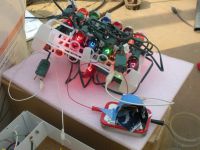
The LED meters were hard to read in daylight, until some shades were added. Green optical filters would probably also help.
Here are today's IV curves for 70, 140, 210, 277, and 290 V on primary. Plus an iso-power line at 425 watts.

klugesmith, Sun Nov 18 2018, 10:38PM
So far so good. With nominal primary voltage, I got:
425 watts into a matched resistance.
222 watts with 10 R's in series (14.4 kV x 15.5 mA). This is around where I want to work.
159 watts into a string of 25 Christmas lights, last year converted from parallel to series by snipping wire in 24 places.

The LED meters were hard to read in daylight, until some shades were added. Green optical filters would probably also help.
Here are today's IV curves for 70, 140, 210, 277, and 290 V on primary. Plus an iso-power line at 425 watts.

Re: Neon sign transformer power output
klugesmith, Tue Dec 11 2018, 10:48PM
Once again I forgot to measure the DC resistances of big NST. Sorry, Radiotech, I'll catch up sooner or later.
Last Saturday night I measured NST primary current. It's a key design requirement for high-voltage isolating transformers to go upstream of the NST's. Same setup as before, except with a true-RMS ammeter in series with primary. Primary voltage was set to nominal and many different resistive loads were measured. Also I tried loads of 6, 10, and 20 fluorescent lamps in series.
Hey administrators, the pictures attachment problem here is even worse than last week!
It seems silly to continue this report when I can't upload charts.
Dialog says
"Please note
Allowed file types:
Any other file types uploaded will be instantly deleted."
Primary current ranged from 0.305 A (no load except kV meter) to 3.43 A (short circuit except secondary mA meter). It was 2.3 A at the peak power point (11 kV, 426 W).
I expected it to behave as the sum of two components 90 degrees apart in phase: a fixed magnetizing current and N times the secondary current. Not bad, with N of about 56. Got a better fit with a mixed model for primary current: (quadrature sum of Ia and N * Ipri) + Ib, where N=53.6, Ia=0.1, Ib=0.19. THis is more precision than necessary, and more than is justified by the metering accuracy.
klugesmith, Tue Dec 11 2018, 10:48PM
Once again I forgot to measure the DC resistances of big NST. Sorry, Radiotech, I'll catch up sooner or later.
Last Saturday night I measured NST primary current. It's a key design requirement for high-voltage isolating transformers to go upstream of the NST's. Same setup as before, except with a true-RMS ammeter in series with primary. Primary voltage was set to nominal and many different resistive loads were measured. Also I tried loads of 6, 10, and 20 fluorescent lamps in series.
Hey administrators, the pictures attachment problem here is even worse than last week!
It seems silly to continue this report when I can't upload charts.
Dialog says
"Please note
Allowed file types:
Any other file types uploaded will be instantly deleted."
Primary current ranged from 0.305 A (no load except kV meter) to 3.43 A (short circuit except secondary mA meter). It was 2.3 A at the peak power point (11 kV, 426 W).
I expected it to behave as the sum of two components 90 degrees apart in phase: a fixed magnetizing current and N times the secondary current. Not bad, with N of about 56. Got a better fit with a mixed model for primary current: (quadrature sum of Ia and N * Ipri) + Ib, where N=53.6, Ia=0.1, Ib=0.19. THis is more precision than necessary, and more than is justified by the metering accuracy.
Print this page